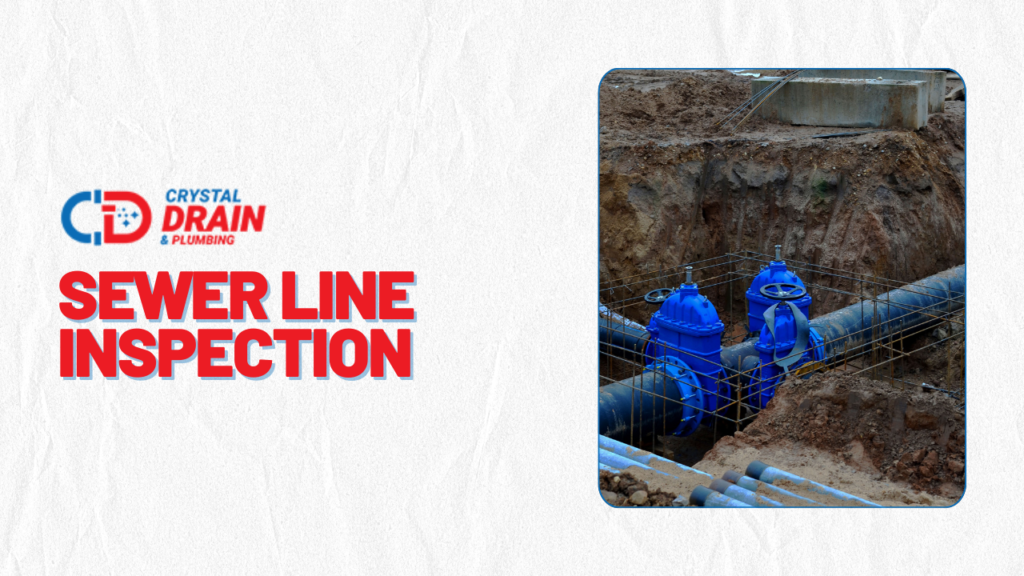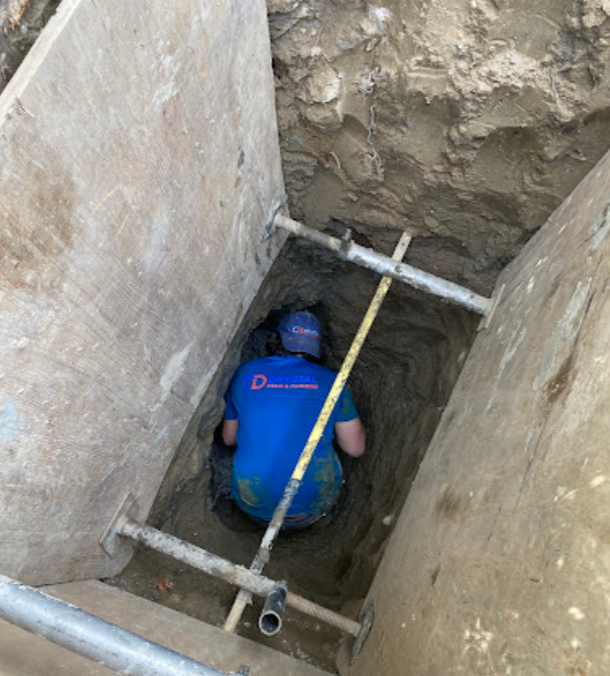Sewer Line Inspection


A sewer line inspection is a critical process used to determine the condition of the pipes that carry waste water away from your home. This inspection is essential for identifying any issues such as blockages, damage, or wear that could lead to serious plumbing problems.
At Crystal Drain & Plumbing, the inspection process is carried out using sophisticated diagnostic equipment such as high-resolution cameras and other specialized tools. These cameras are inserted into the sewer lines to provide real-time visuals of the pipe’s interior condition, allowing technicians to easily identify and diagnose any issues such as obstructions, cracks, or signs of aging.
This preventative measure is crucial in avoiding potential disruptions or major damages, ensuring that the sewer system operates smoothly and efficiently. By detecting problems early, homeowners and property managers can avert costly repairs and maintain the health of their plumbing infrastructure.
Why Consider A Sewer Line Inspection?
Considering a sewer line inspection is crucial for maintaining the health and efficiency of your home’s plumbing system. It helps you:
- Detect Issues Early: Identify potential problems like blockages, leaks, or breaks before they lead to costly repairs.
- Prevent Emergencies: Routine inspections prevent unexpected plumbing disasters, saving you from the inconvenience of emergency situations.Enhance Longevity: Regular maintenance and early problem detection contribute to the extended lifespan of your sewer lines.

- Support Property Transactions: Ensure the integrity of sewer lines before purchasing a property to avoid unforeseen issues and additional expenses.
- Improve Home Efficiency: Ensure that all plumbing systems are running efficiently, which can help reduce monthly water bills and prevent waste.
- Comply with Local Regulations: Meet any local building and safety codes that require regular inspections of sewer systems, especially in older properties or those in areas prone to plumbing issues.
A sewer line inspection offers peace of mind by ensuring your plumbing system is in optimal condition, safeguarding your home from potential damage and costly future repairs.
What Are The Types of Sewer Line Inspections?
Understanding the different types of sewer line inspections can help you choose the right service for your needs. Here are the main methods used:
- Visual Inspection: This basic form involves a direct look at exterior portions of the sewer system to identify any visible issues.
- Video Camera Inspection: A flexible camera is fed into the sewer line, providing real-time video feedback to inspect the condition of pipes internally and identify hidden problems.
- Hydrostatic Pressure Test: This test involves filling a section of the sewer system with water to see if it can hold a specified level of pressure without leaking, indicating pipe integrity.
- Smoke Testing: Safe, non-toxic smoke is pumped into the sewer pipes. Observing where the smoke escapes can help locate cracks, gaps, or other openings along the line.
- Dye Testing: Non-toxic dye is introduced into the sewer system, allowing professionals to observe how it moves through the pipes, which helps detect leaks and verify the system’s layout.
Each type of inspection offers unique benefits, and the choice depends on the specific needs of the property and its plumbing system.
What Is The Most Effective Sewer Line Inspection?
For comprehensive and detailed assessments, video camera inspections are typically the most effective. A sewer line video inspection is a diagnostic technique where a high-definition camera on a flexible cable is inserted into sewer pipes. This method provides real-time visuals of the interior condition of the sewer pipes, allowing for accurate identification of blockages, cracks, root intrusions, and other hidden problems.
It is non-invasive, provides exact locations of issues, and can cover all types of pipe materials and configurations. This makes video camera inspections a versatile and indispensable tool for diagnosing and resolving sewer line concerns efficiently.
Why Opt for A Sewer Line Video Inspection?
- Accurate Diagnosis: Traditional methods of identifying sewer problems often involved educated guesswork and potentially extensive excavation. With video inspection, we eliminate the guesswork. The camera shows exactly where the problem is, whether it’s a blockage, a crack, or root intrusion, allowing for targeted repairs.
- Preventive Maintenance: Regular video inspections can help catch small issues before they become major problems, saving you time and money on future repairs.
- Non-Invasive Technique: Since the camera can be inserted through existing access points, there is minimal to no need for digging up your yard, keeping your landscape intact.
- Quick and Efficient: A video inspection can be completed quickly, typically in less than an hour, and provides immediate results. This efficiency is crucial in emergency situations or when quick diagnostics are required.
- Detailed Analysis: The high-resolution video footage allows our technicians to conduct a thorough analysis of your sewer line. This footage can also be saved for future reference or to verify that a previously identified problem has been resolved.

When Should You Consider a Sewer Line Video Inspection?
- Routine Maintenance: Regular checks help keep your plumbing in top shape and prevent small issues from becoming major ones.
- Before Purchasing a New Home: Ensure there are no hidden sewer line problems that could cause unexpected headaches down the line.
- After a Major Blockage or Backup: Confirm that the issue is fully resolved and prevent future occurrences by identifying the cause.
- If You Suspect Root Intrusion: Check for and address tree root growth that may damage your sewer lines.
- Following Extreme Weather Conditions: Assess potential damages caused by heavy rain, floods, or earth movements to maintain pipe integrity.
- Before Undertaking Renovations: Prevent damage to existing pipes by ensuring they are clear and not compromised before starting significant construction work near them.
Common Problems Identified by Sewer Line Video Inspections
Plumbing camera inspections are a vital tool that can reveal a variety of issues within sewer and drain lines. Here are some common problems that this technology can effectively identify:
- Tree Root Intrusion: Detects roots that have penetrated sewer lines, which can lead to blockages or damage.
- Loose, Broken, or Cracked Pipes: Identifies areas where pipes have deteriorated or become disjointed.
- Complete Obstructions: Finds blockages caused by accumulated debris, roots, or other foreign objects.
- Cracks and Breaks: Identifies specific locations of structural faults in the pipeline.

- Broken Tiles: Reveals damaged sections of ceramic or clay pipes.
- Negative Grade Sloping: Shows sections of piping that do not have proper slope, potentially causing stagnant water and sediment buildup.
- Pipe Sagging: Highlights low points in the line where pipes have sagged or collapsed.
- Pipe Cracks: Provides visualization of hairline to severe cracks.
- Buildups of Sludge or Grease: Identifies accumulation that can narrow the pipe and reduce flow efficiency.
- Corrosion and Wear: Identifies areas where the pipe has corroded or worn down over time, which can affect the integrity and functionality of the sewer system.
Choose Crystal Drain & Plumbing for Expert Sewer Line Inspections!
Opt for Crystal Drain & Plumbing to ensure your plumbing is in prime condition. Our state-of-the-art technology and experienced technicians provide fast, accurate sewer line inspections, preventing costly repairs. Trust us for thorough and reliable service that keeps your system running smoothly. Choose professionalism; choose Crystal Drain & Plumbing.
FAQs About Sewer Line Inspection
It’s recommended to perform a sewer line inspection every 18 to 22 months. If you have older pipes or trees near your sewer lines, you might consider more frequent inspections to prevent unexpected issues.
Regular sewer line inspections prevent major plumbing issues by catching problems early. They help avoid costly repairs, identify pipe degradation, blockages, and ensure your system is operating correctly.
During a sewer line inspection, technicians will insert a camera into your sewer lines. You’ll receive real-time visuals of the pipe’s condition, and the inspector will explain any signs of trouble, suggesting appropriate actions to maintain or repair the system.
Yes, sewer line inspections can detect a wide range of issues, including cracks, blockages, root intrusions, and misalignments. However, they may not detect issues buried deeper within the pipe’s material or under extreme buildup unless specific symptoms indicate such problems.
